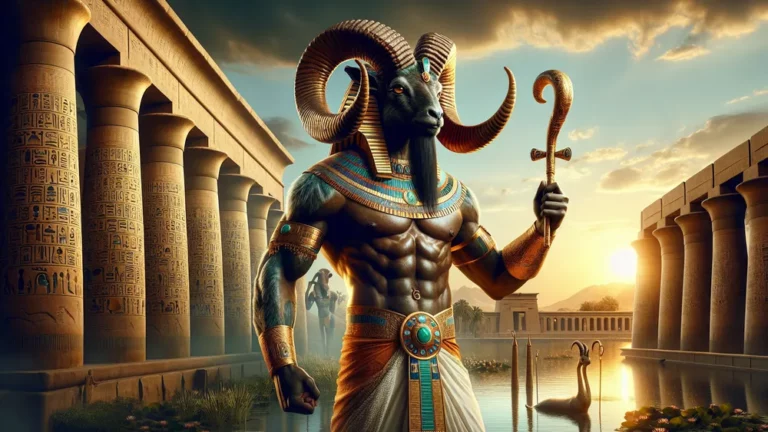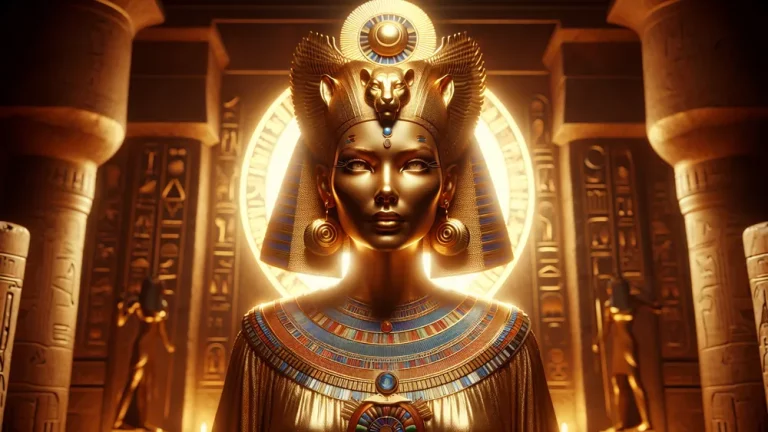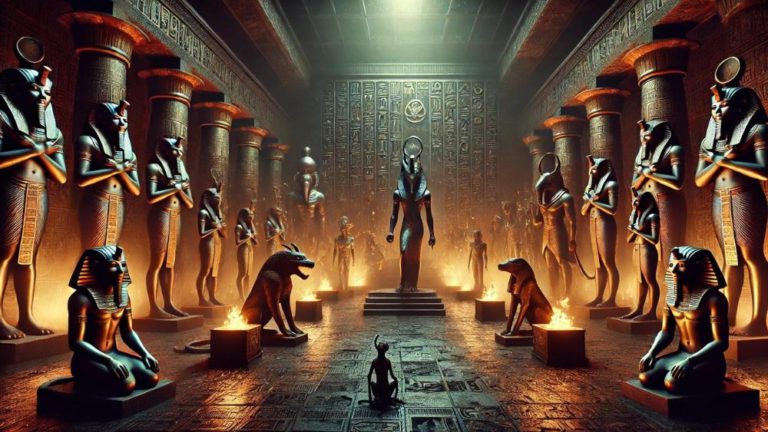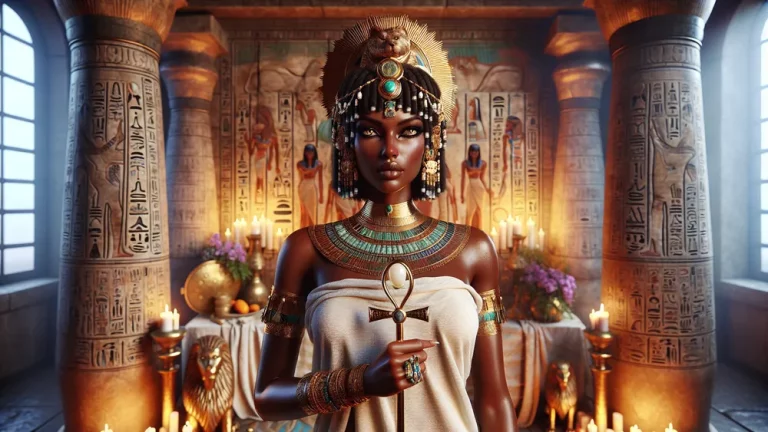Sabazios: Sky Father And Horseman God Of The Thracians
Welcome to our look at Sabazios, a god whose roots go back to the old and mysterious lands of Thrace. As you come along this journey, you might see Sabazios as a many-sided person – an interesting mix of sky father and horseman god – who appears from Thracian stories into the large groups of gods in Greek and Roman tales.
Key Points:
- Sabazios was a god from Thrace, known for being a sky ruler and horseman.
- He became part of Greek and Roman gods, blending with deities like Zeus and Dionysus.
- Sabazios is often seen with symbols like a raised hand and a horse, which means blessing and control over nature.
- People respected him in festivals and ceremonies, offering gifts like snakes and horses.
- Art and writing over time kept his image, showing him as a rider who controls the weather and heavens.
- The connection with other gods like Odin or Jupiter shows a shared theme of sky power.
- Relics like votive plaques found mainly in old Thracian and Roman areas show how important he was.
Thrace is an area where tribes lived, with Greek and Persian cultures intersecting, and it plays a part in how we see the role of Sabazios as a sign of power and rule. Much like other important gods such as Zeus or Odin, Sabazios made his way to fit the cultural styles of regions that took him in.
While we explore further, this beginning builds the base for seeing Sabazios’s qualities, stories, signs, and his lasting mark on both old and new cultures. Because cultures mixed and joined, Sabazios not only kept his Thracian core but also became a vital symbol in Mediterranean godly stories. Through things that were found or words from old books, Sabazios means the connections between old societies and their stories about gods.
Sabazios: Overview and Key Facts
| Key Part | What It’s About |
|---|---|
| Origin | Sabazios comes from Thracian stories, an old place in southeast Europe, now parts of Bulgaria, Greece, and Turkey. |
| Type of Deity | Thought of mainly as a sky ruler and horse guy, with control over the skies and linked with riding horses. |
| Joining Cultures | Because he was part of when cultures mixed, Sabazios joined Greek and Roman gods groups and was also respected in northern areas; he often appeared like Dionysus and Zeus. |
| Main Signs | His big signs include the hand (often seen with an up hand move) and the horse, which points to who he was about godly protection and horses. |
| Main Traits | As a sky god, he was linked with storms, rain, and sky, showing power over weather. |
| Religion Effects | Traditions for Sabazios would usually involve parades, tunes, dancing, and giving, meaning strong customs of respect. |
| Mixing with Others | The things about Sabazios mixed with other gods, meaning the changeable side of old beliefs and customs. |
| Art Showing Him | He is in sculptures, carvings, and wall art, often meaning him as a grand person on a horse or looking up to the sky. |
| Old Mentions | He is talked about in old writings that give ideas about how he was respected, symbols, and the effect he had at different times and places. |
Who is Sabazios?
Because we need to know the nature of Sabazios, we should start looking into his backstory and history, which means we need to see how he moved in different times and places. It’s big.
Backstory and History
Sabazios came from a place full of culture and different groups called Thrace, where old civilizations like the Greeks and the Persians met. Myths in Thrace weren’t written about as much as Greek stories, but gods like Sabazios lived in the common ideas of tribes known for fighting and horse skills.
And it is important to see that Thrace sat in a spot where cultures mixed, allowing stories to swap and take on traits from nearby places. Sabazios, a god of the sky and riding horses, means the ideas and morals of the Thracian people, showing power over the heavens and land.
Like Zeus in Greek tales or Odin from Norse legends, Sabazios was a big deal among his followers, a figure appearing powerful and in charge. When people in Thrace respected Sabazios more, this grew beyond into the Greek and Roman worlds. His identity had to change to be a part of these bigger cultural ideas.

In Greece, he was often seen like Zeus, while in Rome, they saw him as Jupiter, showing the usual practice of blending where different cultural gods appeared the same. This mixing meant Sabazios was more flexible, letting him keep being important in different places even if he did not start from them.
Interestingly, Sabazios also connected with Dionysian rituals, meaning his entry into wild and deep worship acts found there. Sometimes, people worshipped through showing a raised right hand – a sign people still know today – helping spread Sabazios’s worship and meaning how gods got taken and changed by societies to fit their existing beliefs and morals.
Sabazios, a Thracian god associated with sky and horses, became important in Greek and Roman cultures by taking on traits of gods like Zeus and Jupiter, adapting to different beliefs while possibly connecting with Dionysian rituals.
Attributes and Symbols of Sabazios
After we looked closely into Sabazios’s past and where he came from, it’s time to look at the qualities and signs that mean his godlike nature and heavenly power. It’s big.
What Sabazios Looks Like
When shown in old pictures, Sabazios is usually displayed as a noble figure with his detailed symbols and traits, making a clear view of his godlike character. He is a powerful horseman, lined up with pictures meaning authority and control, like Poseidon with his tool by the sea. People who followed him often made him with a raised right hand – it never changes and appears as a symbol meaning divine safety and care. From Thracians’ views, Sabazios is also a figure who rides the skies, being the one who rules the celestial realm. If you need to see these traits clearly, here is a list of key symbols tied to Sabazios and what they stand for:
- The Raised Hand: It means blessing and safety, often appearing in things showing the god.
- The Horse: Shows his part as a divine rider, showing control over both the skies and the ground.
- Serpent Imagery: Sometimes, snakes are with him, meaning rebirth and the circle of life, matching with other Mediterranean symbols.
- Throne or Chariot: These mean his important role among gods, like a king’s chair or a divine ride.
Myths and Stories
After we looked at the simple qualities and signs of Sabazios, we’ll now look deeply into the interesting myths and stories that mean or tell about his trip through the skies and his effect. They’re long.
The Tale of Sabazios: The Sky Rider
Stories about Sabazios, the Sky Rider, cover how he is a grand figure moving through the skies, controlling the skies and changing the natural things. Just like Zeus using thunderbolts, Sabazios is a deity with mastery over weather events, such as thunder, lightning, and rain.
Some tales say that Sabazios rides a golden snake or a horse with wings, and that shows his control over the sky and quick power. This picture is similar to Greek tales of Helios or Apollo driving a chariot across the sky and shows how Sabazios is important for running the universe.
In many northern areas, especially in Thracian places, Sabazios was not only a strong god of the sky but also a protector who kept his people safe from wild forces of nature. The big reach of Sabazios’s stories also means his part in farming growth, where his control over rain made him a vital god for good crops.
How he acts with the seasons tells us he’s like the force of life coming back again, just like other myth figures such as Demeter. Earth symbols, like the snake, make his tie to the earth and its renewing cycle even stronger. These stories were key in events and special acts meant to respect Sabazios and make sure of good seasons.
Even though these tales are rich and complex, it’s important to know that different people see them differently and change them to fit local ways and needs – like when gods mix traits with others nearby in old belief systems.
Sabazios and His Worship Methods
People showed respect for Sabazios through many old-time rituals and celebrations that highlighted his role as a divine sky god. His worship, which was clear in Thrace and later taken into Greek and Roman customs, often had rites that symbolize renewal and protection.
Devotees would sometimes act like Sabazios traveling the sky by using rider models or pictures that mean his heavenly strength. These models worked like religious icons today, letting people feel closer to the god. Offering gifts was normal in old worship, including items like fake snakes, horses, and hands, connecting to his holy symbols.
These gifts mean how sincere the believers were, much like candles or incense used today in spiritual places to mean faith.
Festivals for Sabazios were lively times offering people a space for worship and to notice his power over nature and human events. However, different places did things in unique ways, reflecting the mix that happens when gods cross into new cultures. Some areas focused on his underworld sides, which means through night-time ceremonies and using symbols like snakes to mean life and growth. For a better idea of how people honored Sabazios, look at this list of big rituals and practices:
- Initiatory Rites: Ceremonies marking the start or restart of joining the religious community, often with pretend trips or changes.
- Votive Offerings: People gave items like snake or horse models to gain favor or say thanks.
- Seasonal Festivals: Celebrations during key farming times that showed his effect on growth and lots of food.
- Statues and Effigies: Physical pictures of Sabazios, like riding on horseback, used in places of worship to help connect spiritually.
How Sabazios Left His Mark
Since we found many ways Sabazios was respected, let’s now look at how his divine presence spread across time and places, changing other gods and beliefs.
Sabazios Blending with Dionysus and Zeus
The mixing together of Sabazios with Dionysus and Zeus is an interesting example of how old cultures combined gods through syncretism. This joining likely came about as Thracian people mixed with Greek communities, who saw similarities in the sky-traveling Sabazios and their god of celebration, Dionysus. Both gods had traits linked to energy, change, and nature connection, making their syncretism sensible and easy.
For instance, Dionysus’s link to the vine and growth fits with Sabazios’s farming effects. In the same way, as Dionysian events celebrated rebirth and change, Sabazios’s earth aspects added another side that stressed life cycles, which were common themes in farming societies.

Like how music styles blend by joining parts from each to make something new, this mix let both traditions change and spread across the Mediterranean. Also, Sabazios’s joining with Zeus means their role as sky gods came together. Zeus, the top god in Greek stories, ruled the sky with control over thunder, lightning, and weather parts, much like the Thracian view of Sabazios.
The similarities probably helped Sabazios merge into Greek beliefs since he was already honored as a strong sky father by Thracians. This syncretism could be compared to how local stories merge into bigger cultural symbols, like regional heroes becoming national figures.
These shared traits, like divine power, protection, and control over nature, helped fit myths together easily, so Sabazios stayed and adapted in the larger Greco-Roman system. Moreover, this combination shows how easily divine traits were shared, blending broad god characteristics to meet the different spiritual wishes of many groups.
Sabazios, Dionysus, and Zeus characters got mixed together as people from old cultures found similarities in their traits and beliefs, which made this blend happen naturally and helped these ideas to spread and change.
Broader Thracian Mythology
Since we looked at Sabazios’s blending into the large Greek-Roman group of gods, now it is time to look more into the wider area of Thracian mythology to find out how he and other gods worked in their native spiritual landscape.
Comparing Gods in Thrace
In the wide mix of their myths, Sabazios was among important gods sharing the spiritual stage with several other gods, each showing different parts of life and nature. For example, Bendis was like Artemis, linked to the moon and hunting. This highlighted how Thracians respected nature and the sky. Also, Zalmoxis, seen by some as a god and by others as a man made into a god, meant ideas about life after death, echoing themes seen in beliefs with one main god like the idea of returning to life. The connections among these gods were like those in other old cultures, where gods had roles that explained what was important in society and how people lived. To show these divine roles more clearly, here are some key traits:

- Sabazios: Seen as a sky father connected to the sky and weather.
- Bendis: A hunter with links to the moon, key for group events and growth.
- Zalmoxis: Tied to ideas of not dying, likely a man turned into a god, showing spiritual knowledge and beliefs about life after death.
Sabazios in Art and Literature
Since we looked at the many-sided roles of the Thracian gods, it is clear that Sabazios’s impact is remembered through old art and writing, which means a strong influence in different cultures.
Artistic Views Over Time
Pictures of Sabazios tell an interesting story about how different people saw what he meant over time. In Thracian and Phrygian views, pictures often had him as a rider, mixing the roles of horseman and god, something similar you see, like modern images show leaders on horses to mean power. As he was worshiped more in Greek and Roman places, images changed.
For example, Roman images often used styles that meant they mixed with the wider cultural group of gods. Sabazios is shown as a sky father and a rider in the sky with hands raised, which means he controlled the weather. His pictures in the sky relate to common old symbols of the sky, like a crown might mean control in pictures of leaders.
As his worship went through different views, artists made pictures that sometimes added local or new gods to his early traits. This is kind of like when companies change icons to fit new markets, keeping main parts the same. Artifacts like offering hands and small statues found mainly in Roman lands mean he had a big impact, hinting at rituals done for him. These artifacts tell us about what society values, showing actual mixing at a clear level. To understand how his art changed, here are some important artworks and where they were found:
| Artwork Type | Location | Cultural Time |
|---|---|---|
| Votive Hands | Roman Britain | Roman Empire time |
| Mounted Statuettes | Thracian Bulgaria | Old Times |
| Reliefs | Phrygian Anatolia | Before Greek Time |
| Frescoes | Southern Italy | Roman Republic |
The pictures across time and places show many images of Sabazios, explaining his wide impact and lasting presence across the old Mediterranean scene.
Mentions in Old Texts
Sabazios shows up rarely but is important in old books, where writers explain different parts of his god role. People reading texts like those by Sophocles and Macrobius would see him linked to Dionysian and Bacchian rites, which means mixing gods in Greco-Roman ways. This linking is like how records might mix leaders with the same roles from different places.

Pausanias, in “Description of Greece,” tells us about rites maybe for Sabazios, which means he played a big part in Hellenistic religion. These stories often said Sabazios was a god of the sky, meaning he controlled weather things. The changing ideas of what he did across books tell us myths were flexible, fitting changing spiritual and cultural needs.
Comparative Mythology
Now that we know more about Sabazios through art and writing history, it is time to see his interesting similarities with other gods in different cultural stories.
Similar Deities Across Cultures
In a large group of world stories, Sabazios is matched by gods like Odin from Norse legends and Jupiter from Roman beliefs, each having control over the sky and great knowledge or power. Odin, a bit like Sabazios, appears as someone with big knowledge and leadership and has the trait of being a wanderer, like Sabazios as a godly rider.
Meanwhile, Jupiter, much like him in ruling the sky, holds traits of a strong, protecting sky father who controls thunder and rain – a typical similarity like modern energy networks spreading power everywhere.
The mixing and swapping seen in these gods point to a common human habit to shape divine figures based on shared cultural goals and understandings, which might change in stories but always try to explain key truths about the world and human life.
Cultural Depictions and Modern Legacy
After we looked at Sabazios‘s links to other gods, next, we see how his image has lasted and changed in cultural pictures and the traces he leaves in today’s modern legacy.
Sabazios’ Recognition and Legacy
You can see Sabazios’s impact from many ancient things found and cultural mentions that continue to tell us a lot about his large impact, especially in places like the Thraco-Phrygian areas and the Roman Empire, where statues and sanctuaries have come up. These old items, kind of like well-kept memories from the past, give us important clues about how people used to worship Sabazios and what they thought about him. Today, researchers put together these finds to show his role in the mixing of religions and cultures across old Europe. Main evidence that he is still known includes:
- Ancient finds of votive hands that have writings or symbols linked to Sabazios.
- Items and tokens from old places, showing how big his worship was.
- Mentions in history books that help explain how Sabazios was mixed with gods from other stories, highlighting how his image could change but still stay strong in different cultures.
The Pantheon of Thracian Mythology
This group of gods shows a lively mix for all parts of life, earth to sky and even the mysteries after life ends. It tells us about a complicated belief system; it reflects how they lived and the world around them.
In it, there are important figures such as Bendis, the goddess of the moon and hunt, respected a lot like an essential group member who watched over key parts of community living. Unlike better-known Greek myths, many Thracian stories are hard to figure out because few texts survived. But some old things found in digs have made clearer their religious ways and the ranking of their gods.
When we soon look at Greek mythology, this detailed list of all the greek Mythological Heroes And Figures will mean more insights into comparative mythological studies.
FAQs
1. How did Sabazios transcend into Roman and Greek mythology?
Sabazios transcended into Roman and Greek mythology through syncretism, aligning with deities like Zeus and Dionysus, and integrating his worship practices into their cultural religious framework.
2. Are there any surviving temples or relics of Sabazios?
There are no known surviving temples dedicated to Sabazios, but relics such as votive plaques and reliefs bearing his symbols have been discovered, particularly in regions once inhabited by Thracians and their Romanized successors.







